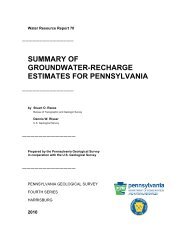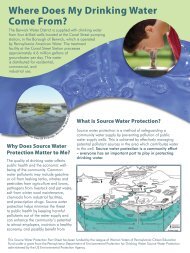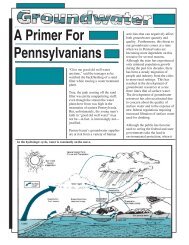NITROGEN POLLUTION: - Hubbard Brook Research Foundation
NITROGEN POLLUTION: - Hubbard Brook Research Foundation
NITROGEN POLLUTION: - Hubbard Brook Research Foundation
You also want an ePaper? Increase the reach of your titles
YUMPU automatically turns print PDFs into web optimized ePapers that Google loves.
alone. Even brook trout, a relatively acid-tolerant species, cannot withstand inorganic<br />
aluminum concentrations above 3.7 micro-moles per liter (100 micro-grams of aluminum<br />
per liter). This increase in aluminum can occur even in acid-sensitive watersheds<br />
where the forest retains much of the nitrogen that is deposited from the atmosphere.<br />
For example, in a Catskill, New York watershed that retains up to 80 percent of the<br />
atmospheric deposition of nitrogen, fish populations still cannot survive due to high<br />
levels of aluminum.<br />
l Forest effects<br />
<strong>Research</strong> to date has shown that acid rain can affect forest health in two ways:<br />
(1) direct impacts on foliage, and (2) reduced stress tolerance associated with soil<br />
changes. The direct impacts on foliage include<br />
the loss of important “membrane-associated”<br />
calcium from tree species like red spruce that<br />
can reduce cold tolerance and induce freezing<br />
of foliage at high elevations. This has lead to<br />
the dieback of 25-50 percent of the large<br />
canopy red spruce in the White Mountains of<br />
New Hampshire, the Green Mountains of<br />
Vermont and the Adirondacks of New York.<br />
The reduction in stress tolerance associated with<br />
acid rain is linked to a loss of the available<br />
calcium and magnesium in the soil that tends<br />
to make several hardwood species more<br />
susceptible to insect infestation, disease or<br />
drought. Signs of stress connected to acid rain<br />
have been documented in sugar maple stands<br />
on sensitive soils across the region.<br />
In addition to acid rain effects on the<br />
forest, high levels of nitrogen deposition may<br />
change forest processes in other ways. <strong>Research</strong><br />
from Europe and the U.S. has identified a<br />
Wood Production (grams per square meter*)<br />
8000<br />
7000<br />
6000<br />
5000<br />
4000<br />
3000<br />
2000<br />
1000<br />
0<br />
Pine<br />
*Results for 8-year period.<br />
Reference<br />
Low Nitrogen (50 kg N/ha)<br />
High Nitrogen (150 kg N/ha)<br />
process known as “nitrogen saturation” that can result from high levels of nitrogen<br />
deposition. Nitrogen saturation occurs when nitrogen deposition exceeds the ability of<br />
the forest to retain all of the nitrogen it receives,<br />
and in its later stages leads to decreased tree<br />
productivity.<br />
One important concept related to nitrogeninduced<br />
change in forests is the highly variable<br />
response of forests to reactive nitrogen inputs<br />
depending on forest type, soil characteristics,<br />
land use history, climate and nitrogen deposition<br />
rates. For example, young vigorously growing<br />
forests and forests with a long history of logging<br />
or agriculture typically have a higher capacity to<br />
Pine stands that received nitrogen<br />
retain nitrogen. Therefore, they progress more<br />
additions. Harvard Forest, MA.<br />
slowly toward nitrogen saturation than more<br />
mature forest ecosystems.<br />
Overall, changes in forest growth due to nitrogen deposition are wide-ranging<br />
and difficult to predict. While some forests may experience increased growth in<br />
response to low levels of nitrogen deposition, other forests respond little or not at all.<br />
<strong>Research</strong> from the Harvard Forest in Petersham, Massachusetts shows that long-term<br />
exposure to very high levels of nitrogen deposition can inhibit growth in pine (Magill<br />
et al. 2000); see Figure 12.<br />
Hardwood<br />
FIGURE 12: k<br />
Changes in forest growth<br />
due to added nitrogen.<br />
From Magill et al. 2000.<br />
PAGE 14













